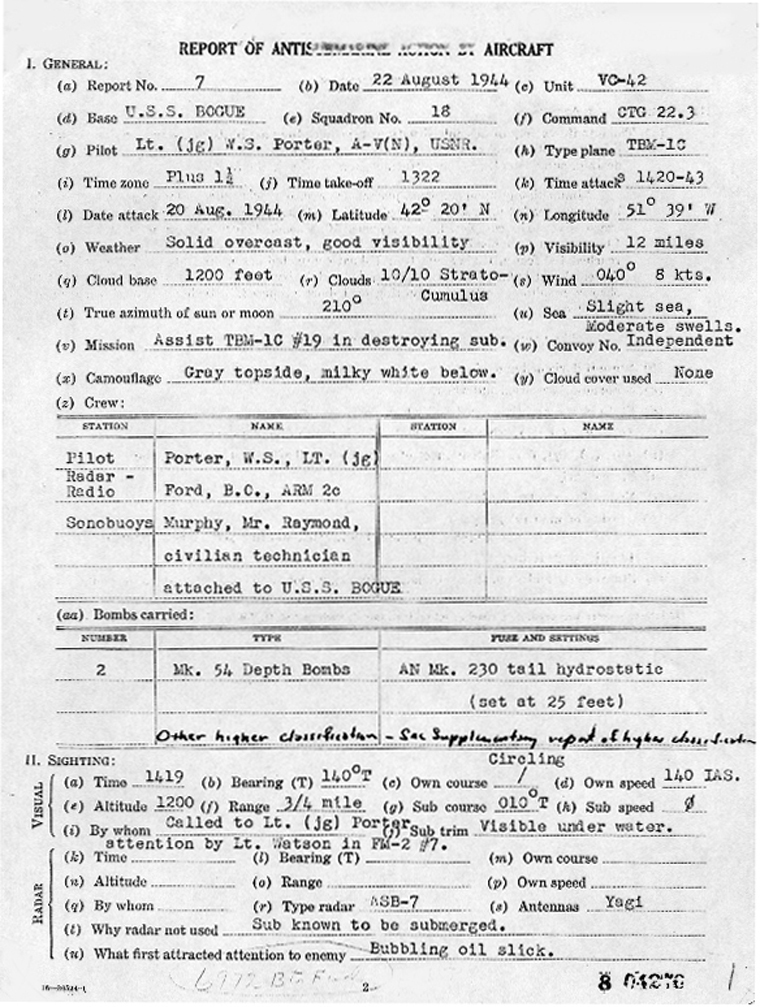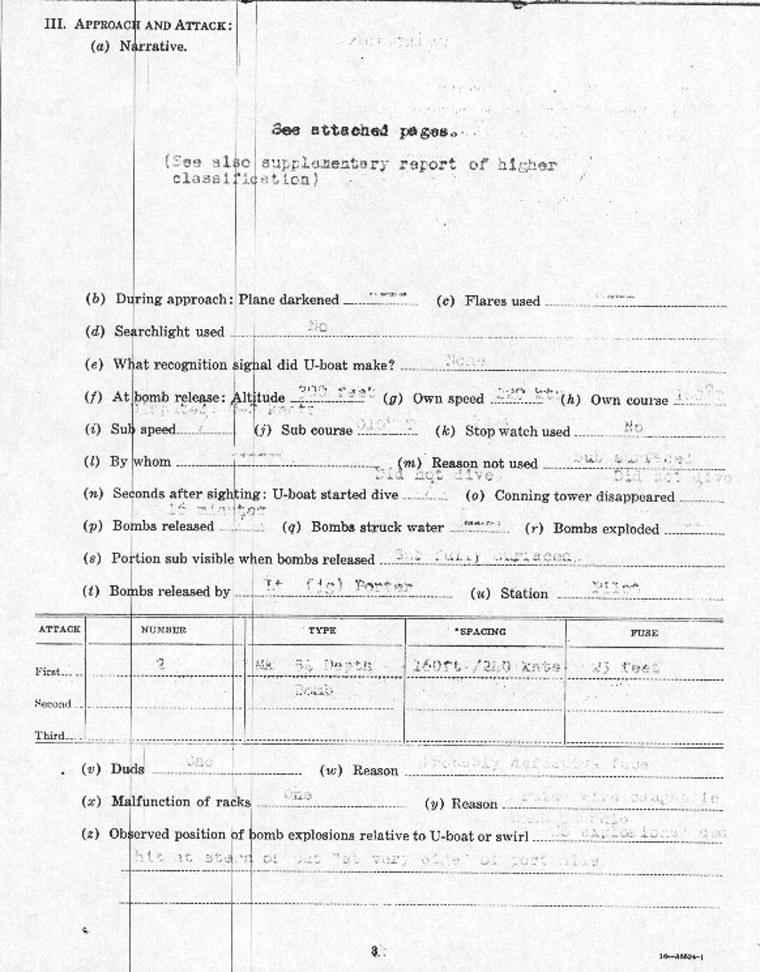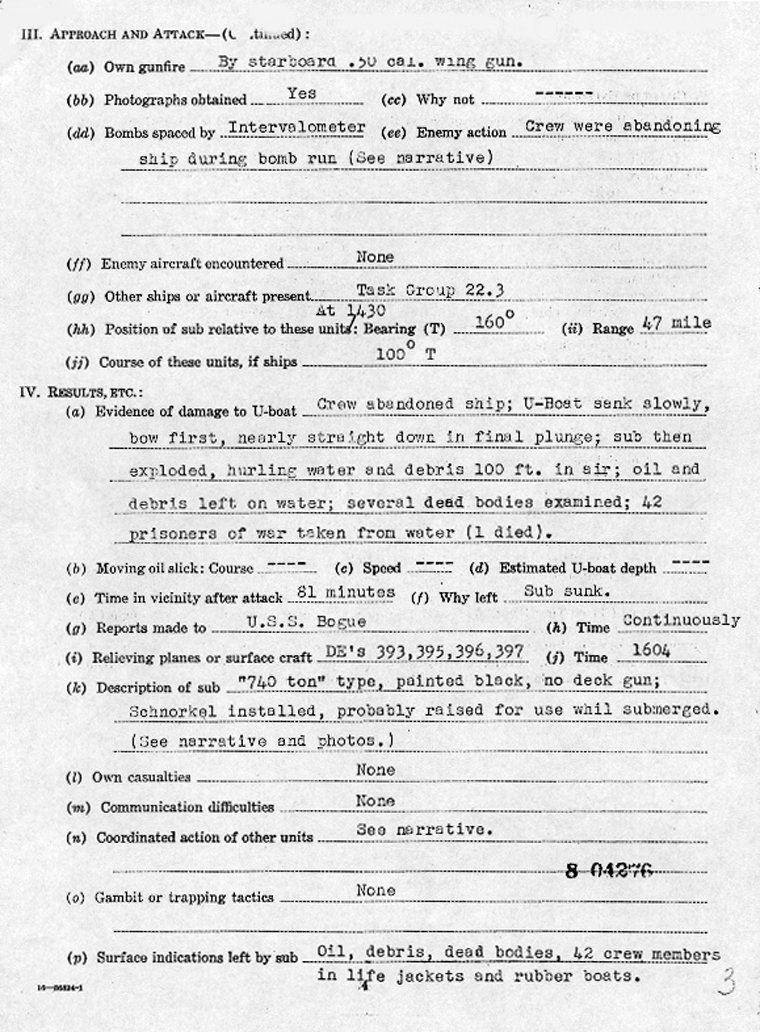


U.S.S. BOGUE |
||
| CVE9/ | ||
| VC-42 |
||
| ASW-6 #7 |
||
NARRATIVE OF CO-ORDINATED ANTISUBMARINE |
||
ATTACK BY VC-42 FROM U.S.S. BOGUE |
||
20 AUGUST, 1944 |
||
| A successful, co-ordinated, aircraft attack upon a German submarine was delivered by three torpedo-plane pilots and two fighter pilots of VC-42, operating from the U.S.S. Bogue, on 20 August, 1944, at 420 20’ N., 510 39’ W. A sixth pilot assisted at the scene with comminations. The attack was made possible by the action of Lt.(jg) A.X. Brokas, of the same squadron, approximately two hours earlier, in locating, severely damaging, and forcing down the submarine. (See ASW-6 Report #6.) | ||
| The attack group was organized upon receipt of Lt.(jg) Brokas’s messages. All planes which were in the air on other search sectors, namely, three TBM-1C’s, were vectored to the scene. The first of these was used for communications and bearings only, and another arrived too late for the action. The remaining planes joined with four more launched by the carrier (two TBM-1C’s and two FM-2’s) for the attack. There was no wind at the time of the launching and therefore, in order to launch the TBMs, it was necessary to lighten them. This was done by removing the rockets. |
||
| The first plane on the scene was TBM-1C #12, flown by Lt.(jg) Mabry. At his arrival, 1336, the U-boat had been submerged about an hour, and Lt.(jg) Brokas was seeking to locate him with sonobuoys. |
||
| To avoid causing Lt.(jg) Brokas to lose contact Lt.(jg) Mabry was ordered to climb to 7000-8000 feet. This was done in order to permit the carrier to obtain a radar range and bearing on the scene of the attack so that other planes, and the escorts, could be vectored accurately to the contact without loss of time. Lt.(jg) Mabry was also used as a radio relay station between the T.G. Comdr. and the other planes at the scene. | ||
The next plane to arrive was TBM-1C #18, Lt.(jg) Porter, accompanied by FM-2 #9, Lt.(jg) Sulton. The tactical command at the scene now was transferred from Lt.(jg) Brokas to Lt.(jg) Porter in order that the former might return to base and the later proceed with the sonobuoy search. Upon submerging, the submarine had left a track of oil for about a mile, the track appearing from the air as roughly V or U shaped. The northwestern tip of this slick had been marked by smoke lights and sonobuoys by Lt.(jg) Brokas, who informed Lt.(jg) Porter the sub was probably just north of this point. Lt.(jg) Brokas thought the sub had submerged on a northerly heading. At 1355, Lt.(jg) Brokas was relieved and ordered to return to the ship. |
||
| The search was concentrated by the first two pilots over the northwestern tip of the slick. Lt.(jg) Porter dropped four additional sonobuoys at this point in hopes of obtaining sub indications. He did not obtain such indications. Meanwhile, however, the rest of the pilots had arrived, Lt. Watson (FM-2 #7) and Lt.(jg) Sherbring (TBM-1C #21) at 1351, and Lt.(jg) Sissler (TBM-1C #16) at 1410. These three commenced to search at the other end of the slick, to the eastward. They soon noticed oil bubbling at that end. At 1419, Lt. Watson picked out the dim outline of the U-boat under the surface at the eastern end, and alerted the attack group. (The sub evidently had submerged on a southerly, rather than a northerly, heading, had turned to the left under the surface, and emitted the tell-tail oil as it proceeded on a semi-circular course. Since it proceeded only about a mile in 1 ¾ hours, it is probable the sub was not underway at the time of this sighting. (See diagram.) |
||
| From the moment Lt. Watson located the U-boat beneath the surface until it had been completely disposed of 24 minutes later, the killer group of three TBM’s and two FM’s was engaged in throwing everything they had at the undersea vessel. Every type of ordinance supplied to VC squadrons was utilized, including depth bombs, rockets, .50 cal. Wing and turret guns, and other special equipment. While hits were not made with every type, the number of hit achieved was sufficient for the purpose. Had the engagement lasted any longer, the two reserve pilots, Lt.(jg) Mabry and Law, in TBM-1C #12 & #10, would have been valuable for, in the 24 minute engagement the other pilots had completely expended their ammunition and bomb loads. | ||
U.S.S. BOGUE |
||
| CVE9/ | ||
| While the pilots and turret gunners were strafing, the TBM radiomen were taking pictures with their hand-held K-20 cameras. Many excellent views of the U-boat, including its Schnorkel, were obtained. With the K-25 automatic wing cameras, the pilots obtained views of their early attack runs. Because their film was soon exhausted, however, they could not obtain similar shots on later runs after the sub had fully surfaced. Under these circumstances, the K-20’s were especially useful. |
||
| The swift sequence of events in the co-ordinated attack is outlined in a chronological table included with this report. The pilots showed the greatest eagerness to attack, expending much of their equipment while the sub was still under the surface or at periscope depth. As soon as the submerged sub was sighted, Lt.(jg) porter made a special run and dropped a green sonobuoy. When five minutes later, at 1425, two periscopes and Schnorkel appeared above the surface, two pilots were so eager that they made virtually simultaneous depth bomb runs. When they found that they were approaching each other in glides from nearly opposite sides of the U-boat, (See diagram), each released his bombs, probably 200 feet short of the target, and pulled out sharply. In this case, too much eagerness instead of co-ordination, spoiled the attacks. Lt.(jg) Sissler, the only pilot having rockets at the scene, immediately returned for a rocket attack, which he delivered most successfully. By the time he struck with the rockets at 1428 the sub’s decks were awash and both he and his gunner, Demorest, are positive that seven rockets hit the hull at right angles about 12 inches below the waterline. The first two rockets were released at a slant range of 800 yards, and the next five at a slant range of 300 yards. The eighth hung up in the launcher and was jettisoned after return to the carrier. | ||
| The sub surfaced slowly, apparently without forward motion. Snorkel was easily picked out from the air, but was believed by the pilots to be a periscope. While appearing much like one from a distance (See photo), it is much more easily detected by searching craft than a periscope. Both periscopes were raised, as well as Schnorkel, as the sub surfaced. There was no agreement among the pilots and enlisted crews as to whether the U-boat got under way after surfacing. Several said the sub was making from “one to three knots” before it sank. Others said it never moved after surfacing. Photographs show very little, if any, wake. It is possible that water running out the freeing ports may have been taken as evidence of motion. | ||
| It is equally difficult to determine which attack finally caused the ship to be abandoned. The facts are that Lt.(jg) Sissler’s rocket attack occurred at 1428, and that two minutes later, when the sub had fully surfaced, crew members began to appear in the conning tower and then on deck with life jackets and life rafts. About four or five minutes later, they were jumping over the side in large numbers. There had been no attempt to man the guns after surfacing. There was a mysterious explosion on the starboard side of the conning tower about 1440, but this was after abandonment of the ship had been underway for at least five minutes. Lt. Watson believes this explosion was the result of one of his strafing attacks, probably the explosion of an ammunition ready locker. Some thought the explosion appeared to come from within the sub through the conning tower hatch; and still others that it had occurred in the water beside the conning tower. At any rate, it was noticed that the sub began to sink immediately afterwards. |
||
| It was while the crew were getting into the water, that the third and final depth bomb attack was made upon the submarine. Lt.(jg) Porter made a beam run from the port side, pressing his electrical release button at an altitude of 300 feet, speed 220 knots. The intervelometer setting was 160 feet/240 knots. One bomb let go, hitting on the port side near the stern “right at the edge of the submarine,” but, unfortunately, it did not explode. The other bomb hung up in the bomb bay. Examination later showed that the arming wire had caught in the shackle, thus jamming the bomb. |
||
| Strafing attacks were made continuously by both FM’s and TBM’s from the moment the periscopes and Schnorkel appeared, at 1425, until they disappeared for good at 1443, eighteen minutes later. The fighter pilots estimated they made 7 or 8 runs apiece. The TBM pilots strafed with wing guns both during bombing runs and separately. All said their point of aim was the conning tower. At the end, half a dozen bodies could be seen on the bridge and bandstands; approximately this number were found in the water by DE’s afterward. |
||
| At 1440, the submarine was beginning to go down by the bow. A minute later, the forward part of the boat was under, and the conning tower partly so. By 1442, only the conning tower could be seen. At 1443, the stern lifted above the surface again, the bow nosed over steeply, and the whole craft slid, at a sharp angle, into the sea. Ready for this eventuality, Lt.(jg) Sherbring flew over the swirl in a special attack, a few seconds afterward, but his gear failed to function. As he pulled out, a heavy explosion rocked the sunken U-boat and lifted water and debris 100 feet into the air. There is no evidence to show whether this was a scuttling charge or the result of damage previously done to the ship. |
||
| Circling the area, pilots counted 40 survivors in the water. Lt.(jg) Sherbring dropped Mk. 4 float lights beside isolated Germans to assist the DE’s in locating them upon their arrival. At 1435, Lt.(jg) Mabry had been ordered to come down and join the flight, and at 1440 Lt.(jg) Law had arrived. These fliers and Lt.(jg) Sissler, the three who had been engaged on search mission when the attack began, were recalled immediately after the sinking (1445). The killer group of four planes continued to circle the scene until arrival of the DE’s at 1545 and 1600. They then returned to base. |
||
| The DE’s picked up broken pieces of wood and other debris. Forty-two survivors were taken aboard the Janssen, of whom one, an officer, died that night. The rest were transferred to the Bogue the following morning. Prisoners consisted of three officers and 38 men, including the ship’s executive officer and a self-styled English speaking “propaganda expert.” Papers taken from the prisoners indicated the U-boat was U-1229. | ||
U.S.S. BOGUE |
||||||||||||||||||||||||||||||||||||||||||||||||||||||||||||||||||
| CVE9/ | ||||||||||||||||||||||||||||||||||||||||||||||||||||||||||||||||||
| VC-42 |
||||||||||||||||||||||||||||||||||||||||||||||||||||||||||||||||||
| ASW-6 #7 |
||||||||||||||||||||||||||||||||||||||||||||||||||||||||||||||||||
CHRONOLOGY OF CO-ORDINATED ANTISUBMARINE |
||||||||||||||||||||||||||||||||||||||||||||||||||||||||||||||||||
ATTACK BY VC-42 FROM U.S.S. BOGUE |
||||||||||||||||||||||||||||||||||||||||||||||||||||||||||||||||||
20 AUGUST, 1944 |
||||||||||||||||||||||||||||||||||||||||||||||||||||||||||||||||||
|
||||||||||||||||||||||||||||||||||||||||||||||||||||||||||||||||||
U.S.S. BOGUE |
||||||||||||||||||||||||||||||||||||||||||||||||||||||||||||||||||||||||||||||||||||||||||||||||||||||||||||||||||||||||||||||||||||||||||||||||||||||||||||||
| CVE9/ | ||||||||||||||||||||||||||||||||||||||||||||||||||||||||||||||||||||||||||||||||||||||||||||||||||||||||||||||||||||||||||||||||||||||||||||||||||||||||||||||
| VC-42 |
||||||||||||||||||||||||||||||||||||||||||||||||||||||||||||||||||||||||||||||||||||||||||||||||||||||||||||||||||||||||||||||||||||||||||||||||||||||||||||||
| ASW-6 #7 |
||||||||||||||||||||||||||||||||||||||||||||||||||||||||||||||||||||||||||||||||||||||||||||||||||||||||||||||||||||||||||||||||||||||||||||||||||||||||||||||
ATTACK BY VC-42 FROM U.S.S. BOGUE |
||||||||||||||||||||||||||||||||||||||||||||||||||||||||||||||||||||||||||||||||||||||||||||||||||||||||||||||||||||||||||||||||||||||||||||||||||||||||||||||
20 AUGUST, 1944 |
||||||||||||||||||||||||||||||||||||||||||||||||||||||||||||||||||||||||||||||||||||||||||||||||||||||||||||||||||||||||||||||||||||||||||||||||||||||||||||||
|
||||||||||||||||||||||||||||||||||||||||||||||||||||||||||||||||||||||||||||||||||||||||||||||||||||||||||||||||||||||||||||||||||||||||||||||||||||||||||||||
U.S.S. BOGUE |
||
| CVE9/ | ||
| VC-42 |
||
| ASW-6 #7 | ||
Attack by Lt. (jg) SHERBRING (TBM-1C #21) |
||
| Crew: |
||
| Lt. (jg) M.J. SHERBRING, A-V(N), USNR |
||
| EBERSTEIN, A., AMM 3/c |
||
| BRAUN, E.C., ARM 3/c |
||
| ROCKSTAD, R.H., ART 2/c (Sonobuoy technician |
||
| Attached to U.S.S. Bogue) | ||
| Bombs Carried: | ||
| 2 Mk. 54 Depth Bombs – AN Mk. 230 fuse set at 25’ |
||
| At Bomb Release: |
||
Altitude: 750 feet. Own Speed: 170 Knots |
||
Own Course: 0600T. Submarine Speed: 2 Knots |
||
| Sub. Course: 0100T. Sub. Visible: Conning tower, |
||
| periscopes and Schnorkel |
||
| (Sub. was in act of surfacing) |
||
| Intervelometer Setting: 100 feet/170 knots. | ||
| Bombs fell 200 feet short of target (See “Chronology” |
||
| and “Narrative.”) |
||
| Own Gunfire: |
||
| 680 rounds .50 Cal. wing and turret guns | ||
U.S.S. BOGUE |
||
CVE9/ |
||
VC-42 |
||
ASW-6 #7 |
||
Attack by Lt.(jg) SISSLER (TBM-1C #16) |
||
Crew: |
||
Lt.(jg) B.C. SISSLER, A-V(N), USNR |
||
DEMOREST, B.M., AOM 2/c |
||
CARPENTER, W.J., ARM 3/c |
||
Bombs Carried: |
||
2 Mk. 54 Depth Bombs – AN Mk. 230 fuse set at 25’ |
||
At Bomb Release: |
||
Altitude: 500 feet. Own Sped: 200 Knots |
||
Own Course: 2000T. Submarine Speed: 1 Knot |
||
Sub. Course: 0100T. Portion of Sub. Visible: Only |
||
Periscopes and Schnorkel |
||
(Sub. was in act of surfacing) |
||
Intervelometer setting: 100 feet/200 knots. |
||
Bombs fell 200 feet short of target (See “Chronology” |
||
and “Narrative.”) |
||
Own Gunfire: |
||
400 rounds .50 Cal. wing guns (Turret gun jammed |
||
on first strafing run and was inoperative |
||
U.S.S. BOGUE |
||
CVE9/ |
||
VC-42 |
||
ASW-6 #7 |
||
Strafing Attacks By Lt. WATSON (FM-2) #7) |
||
And Lt.(jg) SULTON (FM-2 #9) |
||
Lt. J. B. WATSON, A-V(N), USNR. |
||
Lt.(jg) J. (n) SULTON, Jr., A-V(N), USNR |
||
Lt. Watson, circling above the eastern end of the oil slick, was the first to spot the U-boat under the surface and flash the word to the other pilots. |
||
Both fighters made their initial strafing attacks when the submarine’s periscopes and Schnorkel appeared two feet above the surface. Each made six or seven later runs at various stages of surfacing and abandoning ship. Both aimed exclusively for the conning tower in an effort to keep the crew from scuttling ship. |
||
Lt.(jg) Sulton put his tracers right on the target despite the fact that his sight was out of order and not illuminated. |
||
LT. Watson reported an explosion on the starboard side of the conning tower right after one of his runs. He thought this probably was the result of his strafing, probably the explosion of an ammunition ready locker. |
||